This paper aims to provide key information to civil society and people’s organizations on the best-available data on risks and impacts of further global warming in Asia, including countries where the Asia Climate Change Consortium (ACCC) member-organizations work.
What is science telling us about the changing climate?
The past two UN climate negotiations in Glasgow (COP26) and Sharm El Sheikh (COP27) promised higher ambition for solutions together for our planet. These summits saw nations make new pledges in enhancing global and national actions across adaptation, mitigation, climate finance, and addressing loss and damage, among other workstreams. Despite these commitments, our world continues to fall short of the degree of action necessary to avoid more catastrophic climate change.
Experts project that accounting for all updated national commitments by the end of COP27 would result in a world warmer by 2.5°C[1]. This far exceeds the targets under the Paris Agreement, which sets a goal of “well below” 2°C compared to pre-industrial levels and an ideal limit of 1.5°C of warming.
The urgency of limiting global warming was reiterated through the Sixth Assessment Report (AR6) of the Intergovernmental Panel on Climate Change (IPCC). Per the findings of its Working Group I, the mean global temperature for 2011-2020 has risen by 1.09°C compared to the 1850-1900 average. Global surface temperatures have also increased since the 1970s
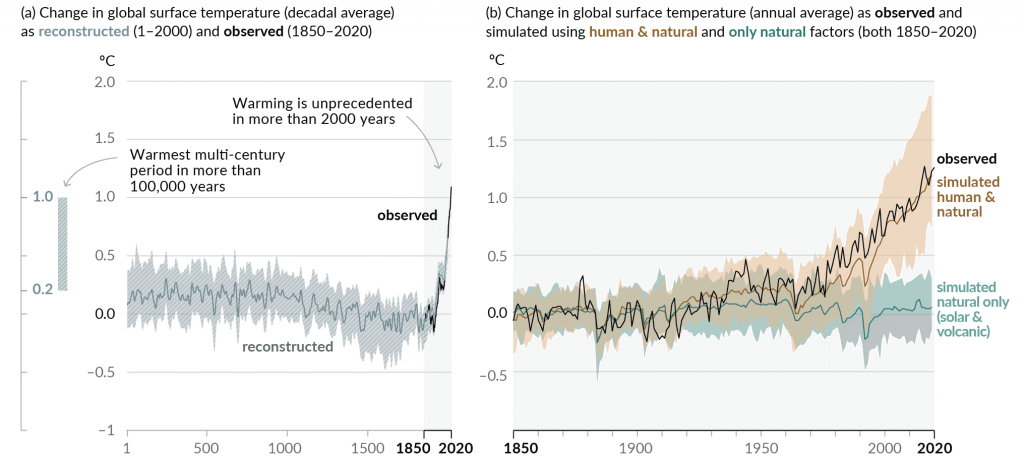
Source: IPCC, 2021, Figure SPM.1
faster than at any 50-year period in the past 2000 years, a clear indicator of global warming accelerating despite higher attention on addressing this matter.
This acceleration is attributed to increased greenhouse gas (GHG) emissions from anthropogenic activities. Global concentrations of carbon dioxide (CO2), the most common global warming pollutant, have reached 410 ppm, the highest in two million years. Atmospheric levels of methane and nitrous oxide are also the most in at least 800 thousand years[2].
Even the COVID-19 pandemic is not enough to permanently reverse the trend of rising GHG emissions. Despite a 5.4% decrease in global CO2 produced in 2020 largely due to the pandemic-induced lockdowns, emissions are back at their pre-COVID rates[3]. This indicates the severity of the climate crisis, and the magnitude of the transformation that global and national economies and societies have to undertake to adequately address its impacts.
Projections currently show that a warming of 1.5°C is likely to be reached on or before 2040[4]. This effectively gives the world two decades to implement drastic decarbonization strategies and avoid the level of heating many consider as a tipping point, wherein climate change impacts may become irreversible.
Under a scenario of the continuing dominance of fossil fuels in the global economy with energy and resource-intensive nations (SSP5-8.5), warming could reach 2.4°C in the mid-term, and 4.4°C by the end of the 21st century. A pathway marked with sustainability (SSP1-1.9) projects a peaking of warming mid-term before decreasing to 1.4°C by 2100.
Table 1. Projections of global warming in the near, mid, and long-term, based on Shared Socioeconomic Pathway scenarios.
| Scenario | Near-term (2021-2040) | Mid-term (2041-2060) | Long-term (2081-2100) | |||
| Best estimate (°C) | Very likely range (°C) | Best estimate (°C) | Very likely range (°C) | Best estimate (°C) | Very likely range (°C) | |
| SSP1-1.9 | 1.5 | 1.2-1.7 | 1.6 | 1.2-2.0 | 1.4 | 1.0-1.8 |
| SSP1-2.6 | 1.5 | 1.2-1.8 | 1.7 | 1.3-2.2 | 1.8 | 1.3-2.4 |
| SSP2-4.5 | 1.5 | 1.2-1.8 | 2.0 | 1.6-2.5 | 2.7 | 2.1-3.5 |
| SSP3-7.0 | 1.5 | 1.2-1.8 | 2.1 | 1.7-2.6 | 3.6 | 2.8-4.6 |
| SSP5-8.5 | 1.6 | 1.3-1.9 | 2.4 | 1.9-3.0 | 4.4 | 3.3-5.7 |
Many countries and communities in the Asia-Pacific experienced the brunt of both sudden and slow onset events under the current global temperature increase. Even the slightest additional
warming would result in significantly stronger climate-related hazards, which places millions more at higher vulnerabilities and risks to loss and damage.
The figure below depicts the differences between the risks presented under different levels of warming, based on downscaled climate models for the Asia-Pacific region. Considering all scenarios used and relative to regional averages, countries within the region will be hit the hardest by heavy rainfall that results in flooding. This is followed by droughts and heat waves, and then tropical cyclones.
A 2°C-heating scenario results in higher impacts across the aforementioned hazards compared to the 1.5°C scenario, except for heat waves. Between the two Shared Socioeconomic Pathways (SSPs) scenarios used, impacts would be higher under SSP2 (i.e., no significant shift in development pathways relative to historical trends) compared to SSP3 (i.e., nations are more focused on domestic issues, material-intensive consumption) across all hazards, except for tropical cyclones.
More CO2 emissions in the future also puts tremendous stress on our ecosystems, especially on natural carbon sinks such as forests, mangroves, and blue carbon. Projections show that with more CO2 being sequestered under scenarios with worse conditions, these sinks become less effective at GHG removal from the atmosphere, especially towards the end of the 21st century[5].
For instance, an emissions pathway marked with sustainability (SSP1-1.9) would result in natural carbon sinks on land and in the oceans store 70% of human-induced CO2 emissions by 2100. However, in the worst-case scenario (SSP5-8.5), this figure decreases to 38%, which is considered as a conservative estimate as climate models used have not accounted for additional ecosystem responses due to warming[6].
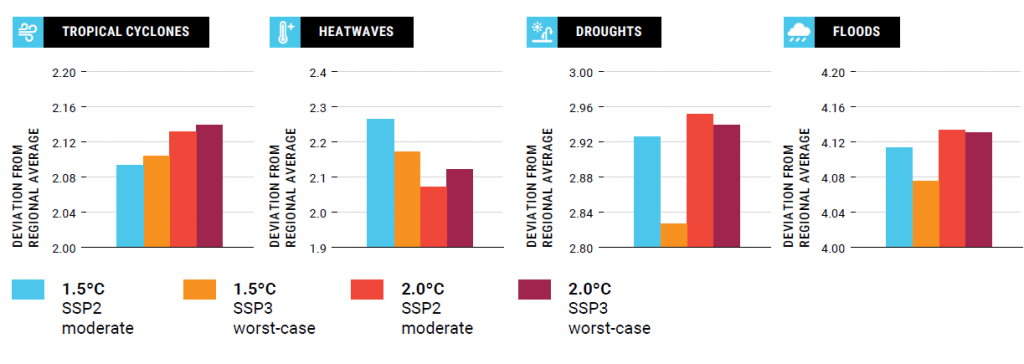
Source: ESCAP 2022, Figure 1
How is climate changing in Asia?
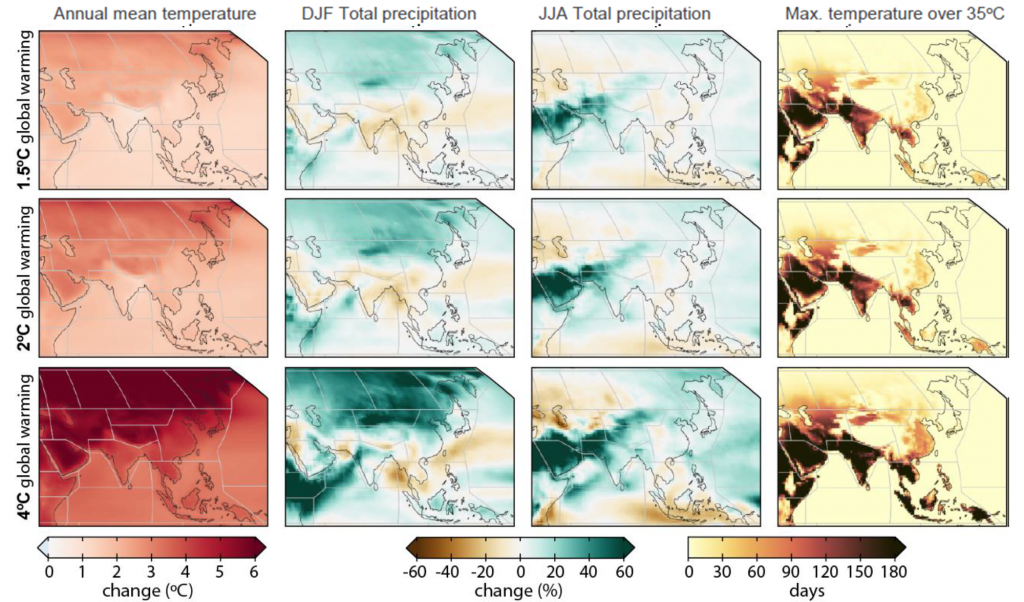
Source: IPCC 2021, Regional Fact Sheet – Asia
While the magnitude of changes vary between different levels of warming, spatial trends on projected climate change are consistent within Asia. Annual mean temperatures would increase the most in northern and southwestern Asia, relative to the 1850-1900 average mean; this could contribute to longer, more intense fire weather seasons. More days of extreme heat could occur in most of the continent; under 4°C of warming, these areas could have as much as 180 days of maximum daily temperatures over 35°C.
Average and extreme precipitation will increase over much of Asia in projected scenarios, although trends differ by region. Drier conditions for the period December to February are likely to occur in parts of India and southeast Asia, while a wetter climate is projected on northern regions and Indonesia by as much as 60% in a 4°C scenario. For June to August, southwestern Asia would experience heavier precipitation than historical conditions, while most of southeastern Asia could be hit by lower rainfall.
Throughout Asia, higher global temperatures would also bring about more marine heat waves, which threaten many ecosystems and biodiversity. The continuing melting of glaciers and thawing
of permafrost would lead to even further rise of sea levels, which is already increasing above the global average. Shorter snow seasons and higher glacier runoff from mountainous areas are likely to happen by the mid-21st century[7].
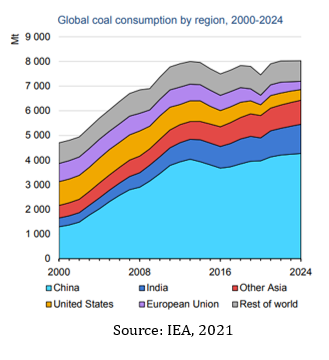
While the continent remains highly vulnerable to the climate crisis, some of its nations remain highly dependent on fossil fuels as indicated by higher energy demand, especially on coal.
As of 2020, China (53%) and India (12%) account for nearly two-thirds of global coal use. The COVID-induced lockdowns showed the resiliency of renewable energy amidst a global crisis, which also led to a decline in coal-fired power generation in 2020. However, the following year saw the increase in electricity demand, which was too much for the cleaner energy supply to meet[8].
As of 2021, coal’s share in the global power mix is estimated at 36%, with record-level increase in coal power generation from India and China. Both coal production and demand are expected to reach all-time highs in the next few years, despite the high risk of fossil fuel infrastructures becoming stranded assets[9].
Another key region on the energy issue is Southeast Asia, rapidly developing for the past two decades. The inflation on oil and gas prices largely driven by the COVID-19 pandemic and the Russia-Ukraine conflict has affected energy security and affordability to the region, which is also one of the most vulnerable to the climate crisis.
Despite these, fossil fuels has been responsible for 90% of the growth in its energy demand. Coal accounts for 26% of its total energy supply by 2020, with its demand increasing by a factor of six since 2000. Demand for oil rose by more than 40% since 2000, while natural gas consumption increased by more than 80% from 2000 to 2020, largely driven by electricity and industry sectors[10].
Many nations such as Thailand, Indonesia, and the Philippines have coal and/or gas-fired power plants in their pipelines[11], threatening the development of renewable energy in the region, GHG emissions reductions strategies by national governments, and their respective pursuit of sustainable development in the following decades.
Southeast Asia
The IPCC AR6 projects that future warming in Southeast Asia would be slightly lower than the global average. Rainfall patterns would differ within the region, with heavier precipitation likely in northern countries and lower rainfall for countries within the Maritime Continent, such as Indonesia and the Philippines. While there is no significant long-term trend on the frequency of tropical cyclones, instances of more intense typhoons have impacted parts of the region and would continue to do so[12], dealing more loss and damage for millions in nations along the typhoon belt.
Under the scenario where warming is likely to be between 2 and 3°C, which is the likely outcome from current national pledges (RCP4.5), more than 327 million people would be exposed to climate change impacts in the region, with an average annual loss (AAL) as a percentage of GDP of 3.6%. These values increase to about 459 million residents and 4.3% AAL under the worst-case scenario (RCP8.5). Under either scenario, Cambodia would record the highest AAL at 8.6%, followed by the Philippines (8.2%) and Lao PDR (7.9%).
The Mekong River Delta is one of the most vulnerable areas in Southeast Asia. More extreme flooding levels is projected for this area due to the cascading impacts of climate change, land subsidence, and local anthropogenic activities. This increases the vulnerabilities of 65 million people living in the Mekong River Delta.
This region is also prone to droughts, with countries such as Cambodia and Lao PDR among those recording large populations affected by droughts from 2011 to 2020, including the El Niño-induced droughts in 2015 and 2019.
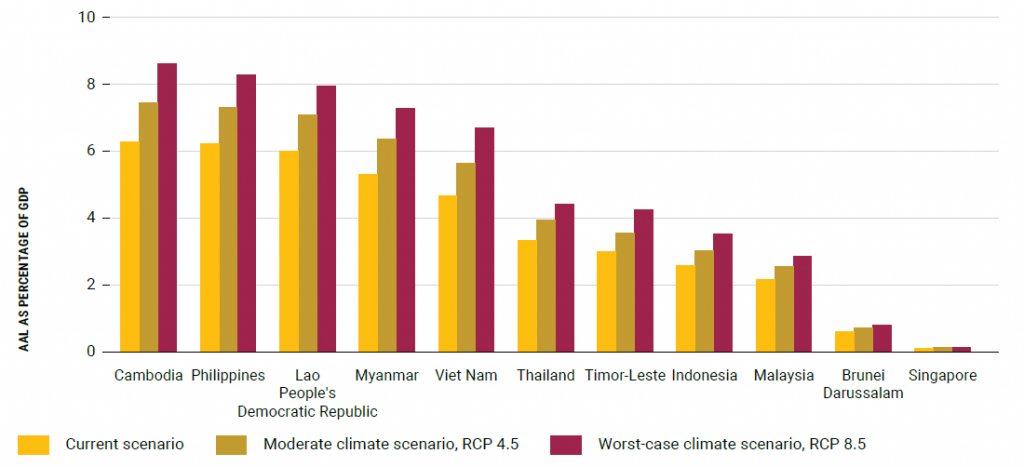
Source: ESCAP 2022, Figure 16
Currently, 48% of the population in the Mekong River Delta and 42% of its economic stock is exposed to floods. For droughts, about 6% of both the population and economic assets are exposed to said climate-related hazard. Under RCP 8.5, this area would be even more susceptible to floods, droughts, and associated biological hazards is set to intensify by the mid-21st century. Other risk hotspots in Southeast Asia, including southern Vietnam, southern Indonesia, and the Philippines would either be at even higher risk or become a new highly-vulnerable area due to further global warming.
Due to climate-related disasters brought by extreme events such as typhoons, nations from the region were among those recorded the most populations internally displaced in 2021. The Philippines saw more than 5.7 million of its residents be forced from their homes, more than any country in the world except for China. Vietnam (780 thousand) and Indonesia (749 thousand) were also among the ten most affected nations in terms of internal displacement[13].
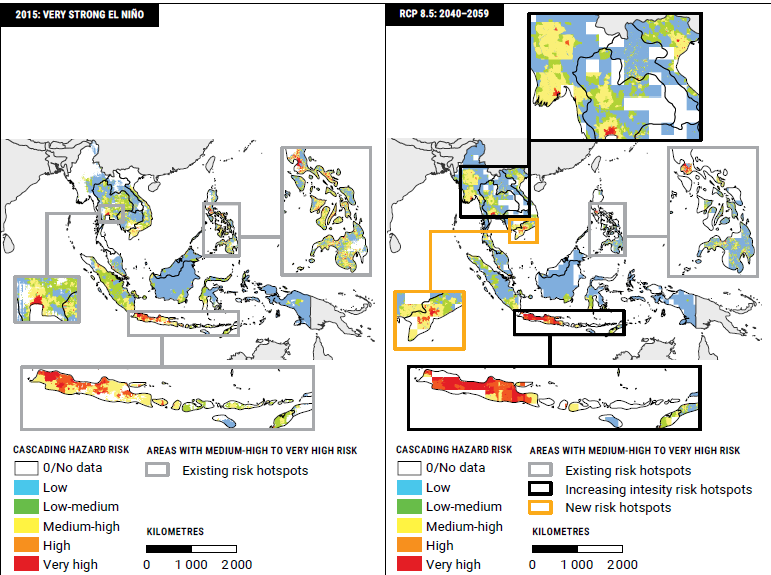
Source: ESCAP 2022, Figure 18
South and Southwest Asia
Nations in South Asia are projected to experience more frequent and intense heat waves and humid heat stress during the 21st century. Both annual and summer monsoon precipitation is also likely during this period, with more variability from year to year. Meanwhile, countries in Southwest Asia observed more droughts since the 1980s and an increase in extreme precipitation in elevated areas. The decrease in snowfall and permafrost have also increased instability on high-altitude areas. Extreme rainfall in terms of frequency and intensity would also increase in this region, with variations depending by season[14].
Under RCP4.5 and RCP8.5, the number of people exposed to climate change impacts are estimated at 1.6 billion and 1.7 billion, respectively, which constitutes at least 80% of the total population in these regions. The AAL for the aforementioned scenarios are at USD216.8 billion (5%) and USD321.8 billion (7%), presenting a significant threat to socioeconomic development. Countries with the highest projected AAL under RCP8.5 include Pakistan (9.1%) and Nepal (8.7%).
South and South-West Asia are exposed to compounding impacts of hazards, such as tropical cyclones, droughts, and floods. Many areas would be significantly impacted by both more frequent tropical cyclones and more extreme temperatures at a 1.5°C-warmer world. Countries such as India and Pakistan have observed more land degradation and a growing area of arid and semi-arid lands. This trend would continue at higher levels of warming, leading to more droughts and sand and dust storms in the next two decades.
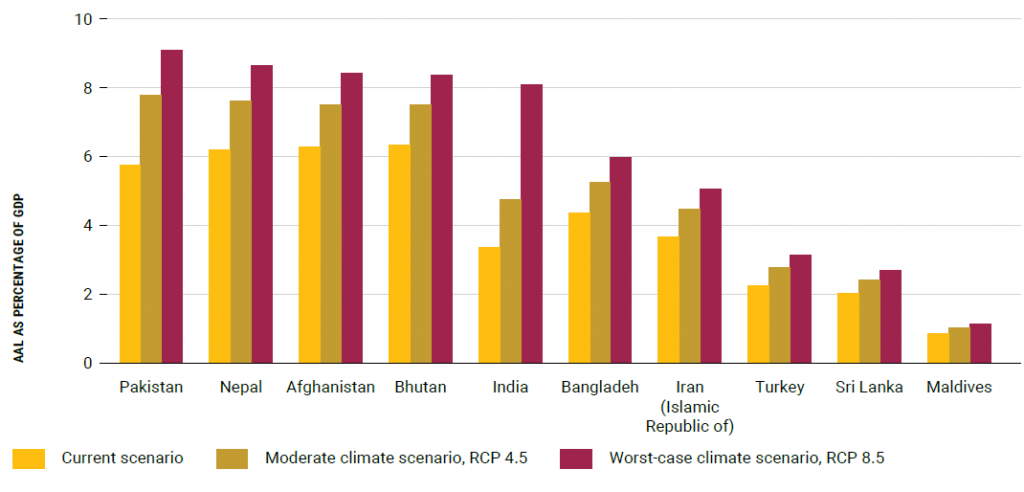
Source: ESCAP 2022, Figure 21
One of the main hotspots in these regions is the Ganga Brahmaputra and Megna basin, home to nearly 300 million people from Nepal, Bhutan, and Bangladesh. About 35% of this population is currently exposed to floods and related biological hazards, while 90% being considered as vulnerable to hazards like droughts and extreme flooding due to poorer living conditions and lower capacities to address socioeconomic issues.
Projections show that this risk hotspot would expand and become even more vulnerable under RCP8.5[15]. A new risk hotspot would also emerge on a sub-region including western India and parts of Pakistan under this scenario.
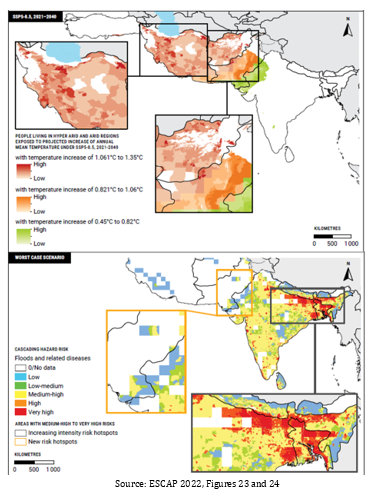
Throughout 2021, more than 5.25 million people in South and Southwest Asia were displaced due to climate-related disasters brought mostly by typhoons and extreme flooding, with more than half being youth under 24 years old. More than 1.5 million residents remained away from their homes due to disasters by the end of the year. India tallied 4.9 million internally displaced peoples, by far the most of any of its neighboring countries. Other nations with notable citizens subjected to climate-induced migration include Sri Lanka (121 thousand), Bangladesh (99 thousand), and Pakistan (70 thousand)[16].
FURTHER DEVELOPMENTS IN SCIENCE TO BETTER INFORM CLIMATE ACTION IN ASIA
- The need to better understand climate impact drivers
Climate scientists have further unpacked the climate impact drivers (CIDs) for climate action. The climate system has multiple variables but there are those which significantly impact humans, societies, ecosystems. These CIDs are physical conditions that may have “detrimental, beneficial, neutral or a mixture of each” depending on the tolerance of a given human, societal, or ecosystem[17]. For instance, coastal CIDs can range anywhere from relative sea level (e,g., with an index of local elevation of astronomical high tide in cities) , coastal flood (e.g., with a sample index of 1-in-100 years extreme total water level relevant to infrastructure), to coastal erosion (e.g., shoreline position change by 2100 relative to present-day as a sample index)[18], among others. It is important to have a clear understanding of these CIDS for crafting and designing appropriate climate actions to save lives and assets.
- Face the reality of compound risks
As countries contend with climatic drivers (e.g., weather events, natural variability, anthropogenic climate change, abrupt changes, tipping points), it must be highlighted that climate drivers can either be singular, compound, or sequential. Alongside with non-climatic drivers in exposures and vulnerabilities, they create compounding risks[19] and subsequently, cascading impacts if peoples are not clearly aware of and have better understanding of the dynamics between hazards, exposures and vulnerabilities.
- Address core vulnerabilities and exposures in humans, societies and ecosystems
Multiple reports have recommended timely and urgent action not only in reducing the root cause of climate change-related hazards but also the root causes of exposures and vulnerabilities that drive risks especially in regions such as the Asia Pacific. Vulnerabilities and exposures of human systems, ecosystems, and their biodiversity should also be given due attention in timely and urgent actions in governance, finance, knowledge and capacity building, catalyzing conditions, and technology. Only when we do so will the world be able to move towards climate-resilient development cognizant of human health and well-being, equity, justice and ecosystem and planetary health.[20]
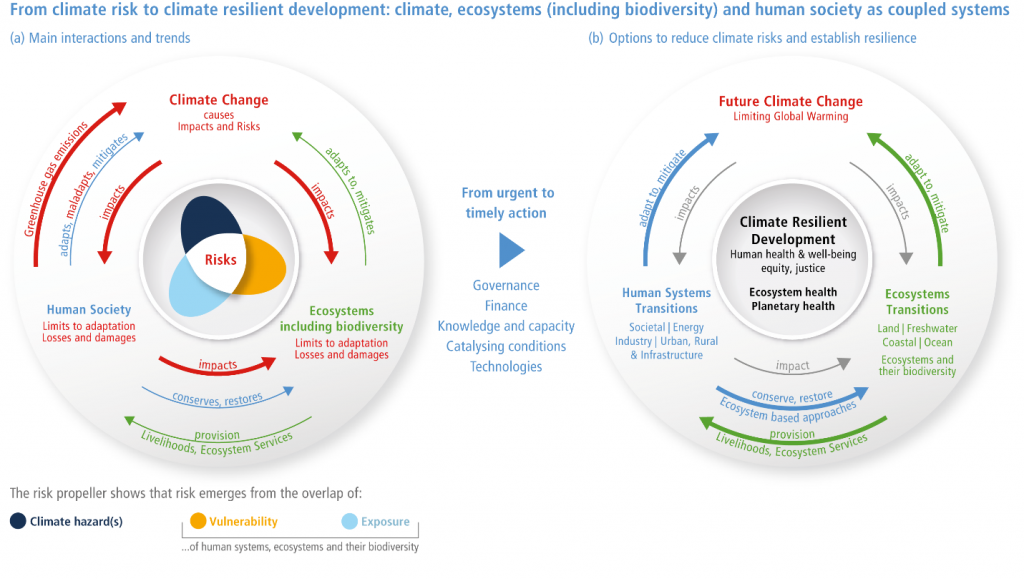
Source. IPCC, 2022 Summary for Policymakers[21]
INSIGHTS AND WAYS FORWARD
With further rise in GHG emissions, climate risks and vulnerabilities of Asia-Pacific countries would also increase. Even a half-degree of additional warming presents a significant increase in threats to food security, livelihoods, public health, poverty alleviation, and other facets of sustainable development. Higher loss and damage, especially endured by the most vulnerable peoples, deprives poorer nations and communities the necessary resources they could have used instead to pursue such development.
Policymakers must also account for the interlinkages among factors that create climate risks. Their interactions with other natural processes and potential human interventions must be factored when designing strategies to avoid or lessen the impacts on communities and ecosystems alike. Such approaches must be implemented in an urgent, holistic, and inclusive manner, with respect to national and local circumstances, different capacities of involved stakeholders, and upholding social and ecological justice.
We highlight that even if countries can implement reduce potential GHG emissions, historical pollution levels in the atmosphere that have caused the impacts we have experienced so far would still continue to trigger adverse effects at least in the short-term, especially on vulnerable areas.
This only enhances the necessity for Asian communities to increase their adaptive capacities and resilience to current and future anthropogenic climate change, with support from developed countries and multilateral funding agencies through just modes of finance. Even with the agreement at COP27 to create a funding mechanism to address loss and damage, drastically reducing GHG concentrations in the atmosphere and oceans remains the most effective way to avoid even worse climate change impacts for countries within Asia.
At COP28 in Dubai, it is time to turn words into concrete actions, based on the best available science. ACCC continues to call for the following:
- Limiting global warming to 1.5°C instead of 2°C to reduce the possible, probable, plausible loss and damage incurred by vulnerable countries and communities in the Asia-Pacific;
- High-emissions countries to raise their ambition and actions through targets and timelines aligned with a 1.5-degree pathway;
- Support the articulation and commit resources to means of implementation of developing nations to mitigating emissions, increase their adaptive capacities and climate resilience to avert and/or minimize losses and damages, and address potential losses and damages of those who no longer have time to build capacities to adapt; and
- Set the foundation for a just transition and societal transformation consistent with the IPCC AR6 recommended pathways of addressing societal and ecosystem vulnerabilities for human, societal, and ecosystem well-being and sustainable development, anchored on climate justice.
REFERENCES
CEED (2022). Financing a fossil future: tracing the money pipeline of fossil gas in Southeast Asia. Retrieved from https://ceedphilippines.com/wp-content/uploads/2022/06/Financing-a-Fossil-Future-Tracing-the-Money-Pipeline-of-Fossil-Gas-in-Southeast-Asia.pdf
ESCAP (2022). Asia-Pacific riskscape @ 1.5°C: subregional pathways for adaptation and resilience. Bangkok: United Nations.
IDMC (2022). Global Report on Internal Displacement 2022. Internal Displacement Monitoring Center.
IEA (2021). Coal 2021: Analysis and forecast to 2024. International Energy Agency.
IEA (2022). Southeast Asia energy outlook 2022. International Energy Agency.
IPCC (2019). Summary for Policymakers. In: IPCC Special Report on the Ocean and Cryosphere in a Changing Climate [H.-O. Pörtner, D.C. Roberts, V. Masson-Delmotte, P. Zhai, M. Tignor, E. Poloczanska, K. Mintenbeck, A. Alegría, M. Nicolai, A. Okem, J. Petzold, B. Rama, N.M. Weyer (eds.)]. Cambridge, UK and New York, NY, USA: Cambridge University Press, doi:10.1017/9781009157964.001.
IPCC (2021). Climate Change 2021: The Physical Science Basis. Contribution of Working Group I to the Sixth Assessment Report of the Intergovernmental Panel on Climate Change [Masson-Delmotte, V., P. Zhai, A. Pirani, S.L. Connors, C. Péan, S. Berger, N. Caud, Y. Chen, L. Goldfarb, M.I. Gomis, M. Huang, K. Leitzell, E. Lonnoy, J.B.R. Matthews, T.K. Maycock, T. Waterfield, O. Yelekçi, R. Yu, and B. Zhou (eds.)]. Cambridge University Press. In Press.
IPCC (2022). Climate Change 2022: Impacts, Adaptation and Vulnerability. Contribution of Working Group II to the Sixth Assessment Report of the Intergovernmental Panel on Climate Change [H.-O. Pörtner, D.C. Roberts, M. Tignor, E.S. Poloczanska, K. Mintenbeck, A. Alegría, M. Craig, S. Langsdorf, S. Löschke, V. Möller, A. Okem, B. Rama (eds.)]. Cambridge, UK and New York, NY, USA: Cambridge University Press doi:10.1017/9781009325844.001.
IPCC (2022). Climate Change 2022: Mitigation of Climate Change. Contribution of Working Group III to the Sixth Assessment Report of the Intergovernmental Panel on Climate Change [P.R. Shukla, J. Skea, R. Slade, A. Al Khourdajie, R. van Diemen, D. McCollum, M. Pathak, S. Some, P. Vyas, R. Fradera, M. Belkacemi, A. Hasija, G. Lisboa, S. Luz, J. Malley, (eds.)]. Cambridge, UK and New York, NY, USA: Cambridge University Press, doi: 10.1017/9781009157926.
Ruane, A. C., Vautard, R., Ranasinghe, R., Sillmann, J., Coppola, E., Arnell, N., … & Zaaboul, R. (22022). The climatic impact-driver framework for assessment of risk-relevant climate information. Earth’s Future, 10(11), https://doi.org/10.1029/2022EF002803
UN Climate Change News (2022). Climate plans remain insufficient: more ambitious action needed now. Retrieved from https://unfccc.int/news/climate-plans-remain-insufficient-more-ambitious-action-needed-now
United Nations Environment Programme (2021). Emissions Gap Report 2021: The Heat Is On – A World of Climate Promises Not Yet Delivered. Nairobi.
[1] UN Climate Change News (2022)
[2] IPCC (2021)
[3] UNEP (2021)
[4] IPCC (2021)
[5] IPCC (2021)
[6] IPCC (2021)
[7] IPCC (2021)
[8] IEA (2021)
[9] IPCC (2022)
[10] IEA (2022)
[11] CEED (2022)
[12] ESCAP (2022)
[13] IDMC (2022)
[14] ESCAP (2021)
[15] ESCAP (2021)
[16] IDMC (2022)
[17] IPCC (2021)
[18] Ruane et al. (2022)
[19] IPCC (2019)
[20] IPCC (2022)
[21] Ibid
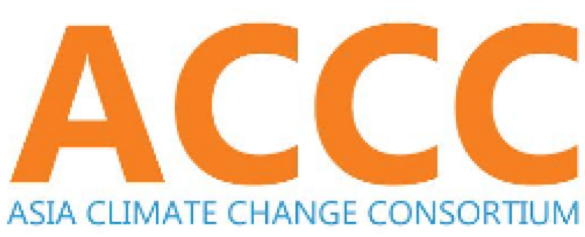
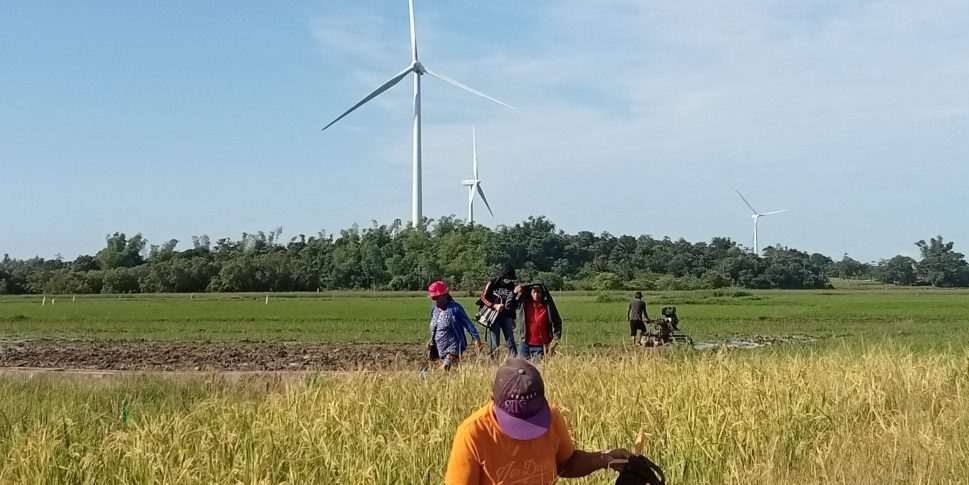


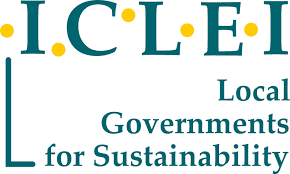
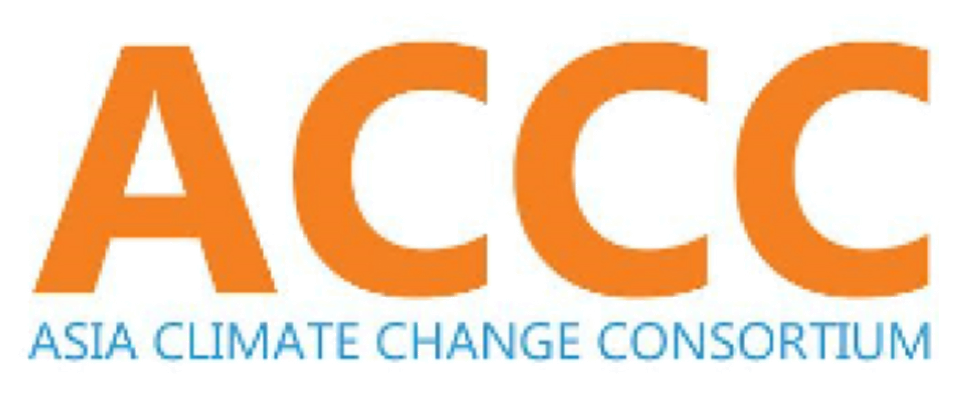 c/o Rice Watch Action Network
c/o Rice Watch Action Network